On test: Fendt 724 Profi Plus
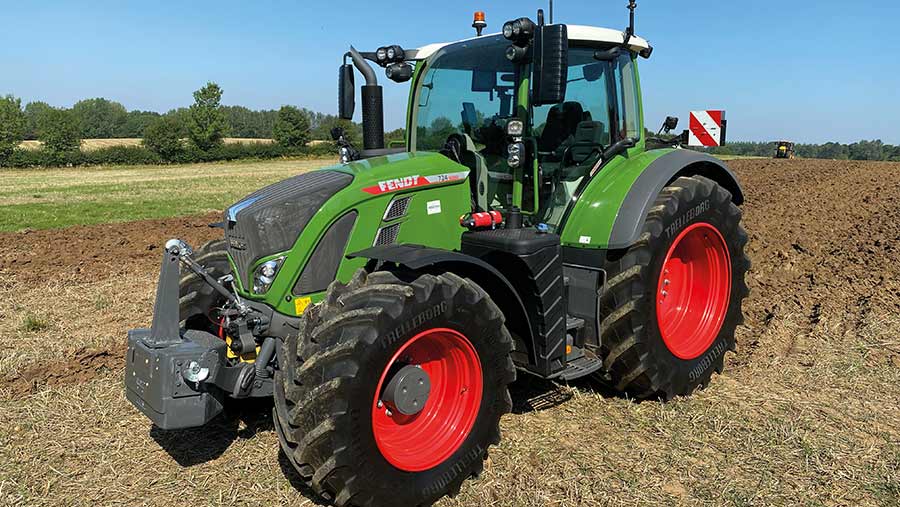 © MAG/Oliver Mark
© MAG/Oliver Mark Fendt has long been the brand of choice for those that like to get technical with their tractors.
When the last 700-series arrived on the scene in 2011, it brought with it a level of sophistication that its rivals spent years trying to match.
Just as they were catching up, the Marktoberdorf-based maker unveiled a fancier set of controls that upped the ante yet again.
The FendtOne driver’s workstation, as it is officially known, came out in 2020 and includes a swish new control layout offering faster processing power, up to three separate screens, and yet more scope for customising the settings.
It has made a significant difference to the way the tractor drives, but it’s the same machine underneath – a 6-litre Deutz engine, two-range CVT transmission and a five-pillar cab frame that’s had some minor tweaks to accommodate the new tech.
See also: Video: Fendt’s debut Cargo T955 telehandler on test
Weighing a shade under 8t, the range-topping 724 is a light and compact tractor considering it offers a max power of 246hp.
This means it can turn its hand to heavy cultivation, haulage work and mowing, without looking out of place on the average fert spinner.
The 700-series, and the 724 in particular, have helped propel Fendt through the tractor sales rankings, going from a relatively niche player to fifth in the UK chart.
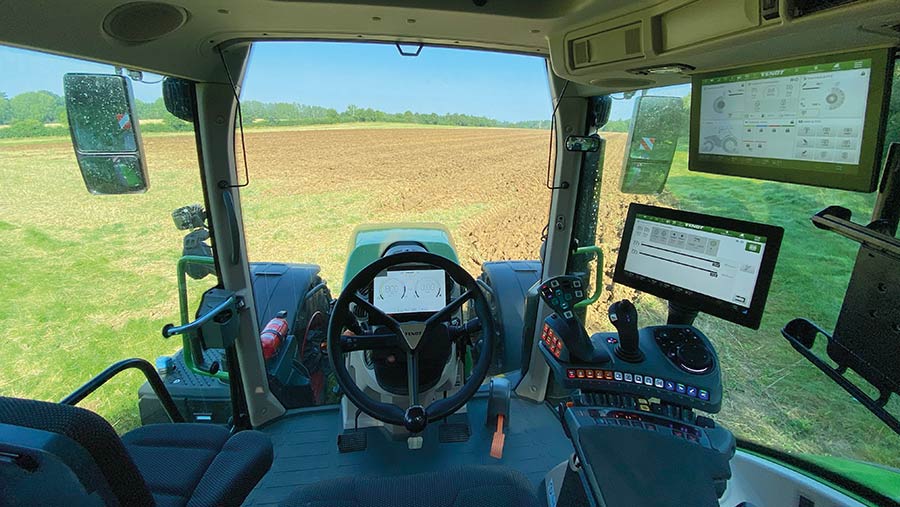
© MAG/Oliver Mark
Quick verdict
The 724’s old cabin was high tech, but the new version steps the electronic wizardry up another level.
For one-brand drivers with the time and ability to make the most of what’s on offer, there is very little to dislike.
But for those that are regularly switching between different makes of machine, it can be frustrating to get it to do what you want.
The rest of the tractor is largely unchanged, meaning it offers ample power in a compact package allied to a smooth stepless driveline.
There’s still a risk of putting strain on the engine and transmission during heavy deceleration, so it needs a considerate operator on the seat.
Approx on-farm price: £165,000
What’s changed?
Almost all the tractor’s controls have been overhauled, with the only familiar components being the air brake, steering wheel and left-hand reverser.
As before, most functions are grouped on the seat-mounted armrest, but this has been heavily redesigned, with a chunkier, squatter joystick that has a lot more going on.
Key additions include proportional scrollers for the spools, a wheel for adjusting cruise speeds, and a bank of extra functions that have been rehomed from the armrest.
Quick access buttons for controlling linkage, four-wheel drive engagement, beacon and the like have been moved to the front of the armrest and the spool paddles no longer have fixed colour coding.
This means operators can shift them around in the screen and they will light up to show which is which – all very fancy.
Also gone are the twin horizontal depth wheels with mechanical detents, replaced with vertical wheels on the armrest that have virtual depth readouts in the screen.
The conventional dash has been swapped for a 10in digital display that can be edited to show different information – on some of the firm’s more basic, lower-horsepower models this is the only screen for setting up the tractor.
Fendt has increased the size of the main display, going from 10in to 12in, and given it sharper graphics.
But, more importantly, it now comes with a higher-powered processor and a new interface that the company says is easier to navigate.
Fendt 724 Vario Profi Plus
Engine Six cylinder, 6-litre Deutz
Rated power 237hp
Max power 246hp
Max torque 1,072Nm@1,500rpm
Transmission Agco ML180 two-range CVT
Top speed 60kph
Weight 7.98t
Max permissible weight 14t
Rear lift capacity 10.36t
Hydraulics 193-litres/min
On top of this, buyers can spec a third screen that drops down from the roof. This carries a similar range of functions to the main monitor, as well as the ability to run Isobus implements.
It will retract halfway into the roof, with the bottom portion still live for displaying information such as the climate control settings or audio.
A new 3L hydraulic joystick has been drafted in as an alternative option to the small spherical version. This has a more conventional shape, integrated shuttle lever and the ability to carry up to 27 functions.
It’s handy for anyone wanting to run a front loader and opens the options for controlling other implements with multiple hydraulic functions.
In a bid to remove clutter, some lesser-used functions have been lumped into the screen, and the climate control panel has been replaced by a small multi-function knob on the armrest.
Fendt has also developed a web-based platform that allows managers to track work progress and fuel use, as well as sharing guidance lines, field boundaries and implement data with operators.
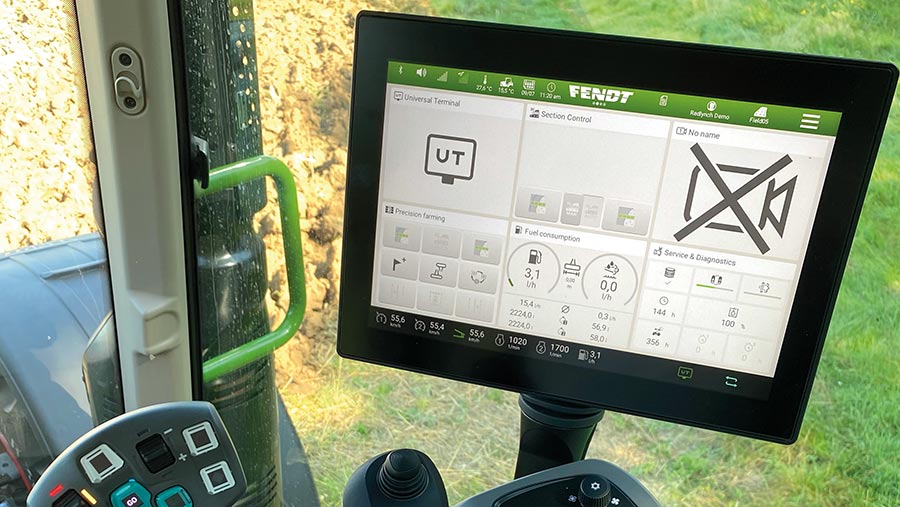
© MAG/Oliver Mark
Is it hard to use?
When the last control layout came out it took a bit of getting used to. But after 10 years of the same setup on all the firm’s tractor ranges, it became second nature to many.
The new arrangement shakes things up again and a good bit of head scratching and fumbled button prodding is required before it’ll do what you want.
For those just hopping on the tractor to do a quick job this can be infuriating. However, for operators spending thousands of hours in the seat each year, it’ll soon become clear.
The climate control is a good example of the added complexity. Before, there was a simple set of dials in the roof, so everyone knew where they were.
Now there’s a single hard-to-spot knob on the armrest that handles all functions with some deft nudging and pressing.
The idea is that it puts all controls within easy reach of the operator, but it wasn’t particularly arduous before.
Some functions have been made more straightforward, though. The new screen layout is intuitive, and we found it simple to locate and alter the settings.
We like the fact that it’s so easy to set up custom run-screens and, with up to six tiles of information on each, plenty of data can be displayed.
Most importantly, the system has far more power than before, meaning it’s quicker and can cope better with processor-hungry tasks such as running individual section control.
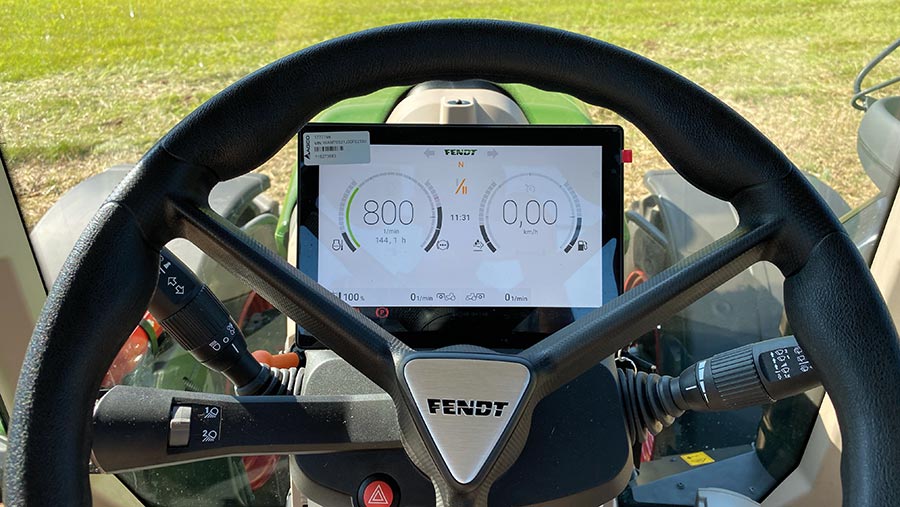
© MAG/Oliver Mark
Best bits of the upgrade?
The software improvements and the sheer number of options mean few people will be hampered by the tractor’s technical ability.
That’s got to be good news for anyone that needs high levels of customisation, such as those in the fresh produce sector using highly complex machinery.
Isobus compatibility also means that the tractor can be programmed to run implements without needing to bring in external controllers and joysticks that clutter up the cabin.
At a simpler level, we rate the new scroll wheel integrated into the joystick, which allows cruise speeds to be tweaked with a slight nudge of the thumb.
Previously, this was dealt with using a dial on the side of the screen, which was less handy for on-the-move adjustments.
The old horizontal linkage depth wheels were never one of our favourite features, and their vertical replacements fall much more easily to hand.
It takes a while to tune into the virtual depth settings, but we think they’re a noticeable improvement.
Audio control is now integrated into the screen, which is more user-friendly than the old Bluetooth radio and puts Fendt back on a level playing field with John Deere.
We also rate the push-dial controller that’s an alternative method of scrolling through the screens and adjusting settings.
With three displays to play with on our test tractor, it felt like running a desk at the London Stock Exchange.
Worst bits?
The move to illuminated buttons offers much more scope for customisation, but when the sun glints off them, they’re not the easiest to identify.
We often found ourselves cupping a hand over the top to get a proper glimpse of what they were showing.
Migrating yet more functions into the screen and adding layers of complication makes the tractor more difficult to drive for a beginner.
Some of it seems unnecessarily flash, but Fendts are supposed to be at the cutting edge so we can’t really grumble.
We’ve never been fans of the tab left-hand reverser – not that we use it very often – and the seat still catches on the cab when you swing it round for a better view of rear implements.
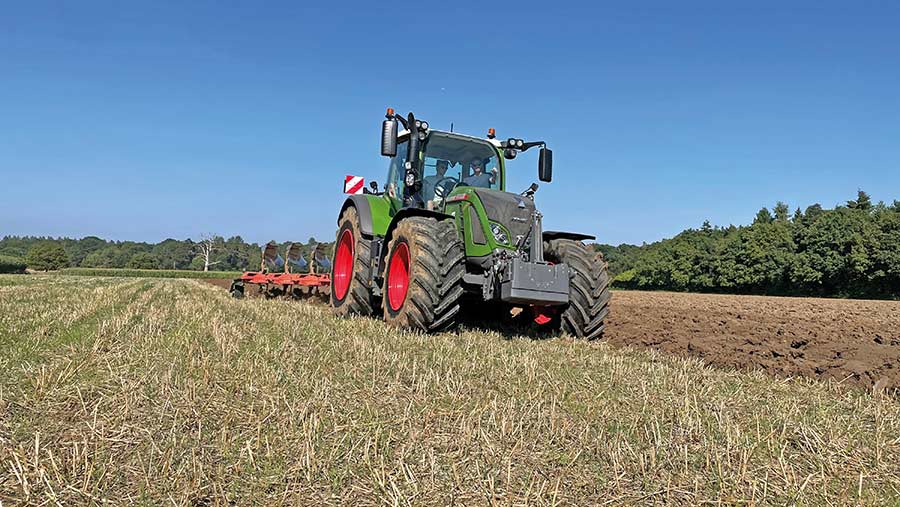
© MAG/Oliver Mark
What’s it like in the field?
Controls aside, the new 724 behaves exactly like its predecessor, meaning it’s smooth, quiet, pulls well and can be used for a wide range of field-work tasks.
Fendt’s TMS system also does a good job of getting the best out of the engine without using too much fuel.
As it’s a compact tractor for the power output, it needs some decent ballasting to get grip for heavy cultivation work and a set of wheel weights is a wise investment.
The transmission clearly saps more power than mechanically biased offerings and there are still two mechanical ranges that need to be changed at a standstill when going from road to field work.
This taints the otherwise effortless power delivery.
The tractor can be driven in stick or pedal mode in the field, and the cruise control functions will work in both.
We prefer to run in pedal mode for ploughing, which allows for easy manoeuvring on the headlands, and then flick into a cruise once the plough is in the ground.
Few tractors can inch on the pedal as accurately as the Fendt, making it excellent for safely hooking up implements or working with a loader.
It’s far better than the Fastrac 4220 we had on test at the same time, which shares the same transmission.
What about the road?
Pedal mode on the 724 makes it a breeze to drive on the road and it’s simple to set a cruise speed for more relaxed driving on long, straight runs.
It is possible to operate it in stick mode, making it drive a bit like a hydrostatic, but we prefer the former technique.
It’s smooth too, but it still can’t match a Fastrac for speed and comfort. And, importantly, it isn’t classed as a high-speed tractor, so it isn’t legally allowed to travel at its top speed of 60kph.
Another downside is that it’s still possible for inexperienced operators to put strain on the engine and transmission if they don’t decelerate in a considerate manner.
The proper approach is to gradually lift off the throttle and use the brakes and exhaust brake to come to a controlled stop.
The range
Fendt offers six models in the six-cylinder 700-series line-up, starting with the 144hp 714 and topping out with the 724.
Four spec levels are available, starting with the stripped-down Power version that’s missing guidance and functions such as the hydraulic crossgate lever. Each step up adds more features, culminating in the top-spec Profi Plus that has all the bells and whistles.
The range is flanked by the four-cylinder 500-series at the lower end and the heavier-duty 800 series above, which runs up to 287hp.
However, some drivers will lift off completely, or even pull the stick back, which signals the transmission to close.
It’s like dropping a car into second at motorway speeds and it doesn’t do the engine or transmission any favours. It’s a shame Fendt hasn’t found a way of stopping the tractors doing this.
Has the engine changed?
No change here. The tractor has the same 6-litre Deutz engine that develops a rated power of 237hp, max power of 246hp and max torque of 1,072Nm at 1,500rpm – Fendt doesn’t bother with boost.
It’s a relatively small engine, with its cousins Massey Ferguson and Valtra turning to a 7.4-litre Sisu powerplant for this sort of power. However, it helps contribute to the tractor’s compact proportions.
Likes and gripes
Likes
✅ Slick screen and controls
✅ Huge level of customisation
✅ Smooth transmission
✅ Compact for power
Gripes
❌ Stationary transmission range change
❌ Light-up buttons hard to view in bright sunlight
❌ Yet more complicated to hop on and drive
❌ Risk of over-revving engine

